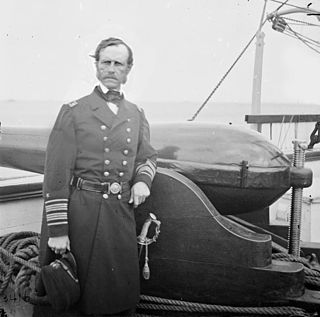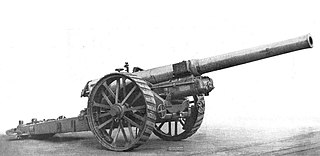
The Montana-class battleships were planned as successors of the Iowa class for the United States Navy, to be slower but larger, better armored, and with superior firepower. Five were approved for construction during World War II, but changes in wartime building priorities resulted in their cancellation in favor of the Essex-class aircraft carrier and Iowa class before any Montana class keels were laid.
The Winchester Model 1897, also known as the Model 97, M97, or Trench Gun, was a pump-action shotgun with an external hammer and tube magazine manufactured by the Winchester Repeating Arms Company. The Model 1897 was an evolution of the Winchester Model 1893 designed by John Browning. From 1897 until 1957, over one million of these shotguns were produced. The Model 1897 was offered in numerous barrel lengths and grades, chambered in 12 and 16 gauge, and as a solid frame or takedown. The 16-gauge guns had a standard barrel length of 28 inches, while 12-gauge guns were furnished with 30-inch length barrels. Special length barrels could be ordered in lengths as short as 20 inches, and as long as 36 inches. Since the time the Model 1897 was first manufactured it has been used by American soldiers, police departments, and hunters.

The two Nevada-class battleships were the first Standard-type battleships produced by the U.S. Navy, and also the first to use triple main turrets. Nevada (BB-36) and Oklahoma (BB-37) were both ordered in March 1911. In armament, armor, and propulsion the Nevada class represented a considerable evolution in battleship design and, in being designed specifically to fight at extreme gunnery ranges, was actually well ahead of its time. They would be followed by the Pennsylvania-class battleships.

The Connecticut class of pre-dreadnought battleships were the penultimate class of the type built for the United States Navy. The class comprised six ships: Connecticut, Louisiana, Vermont, Kansas, Minnesota, and New Hampshire, which were built between 1903 and 1908. The ships were armed with a mixed offensive battery of 12-inch (305 mm), 8-inch (203 mm), and 7-inch (178 mm) guns. This arrangement was rendered obsolete by the advent of all-big-gun battleships like the British HMS Dreadnought, which was completed before most of the Connecticuts entered service.

The .410 bore or .410 gauge, is the second-smallest caliber of shotgun shell commonly available. A .410 bore shotgun loaded with shot shells is well suited for small game hunting and pest control. The .410 started life off in the UK as a garden gun along with the.360 and the No.3, No.2 and No.1 bore rimfires. .410 shells have similar base dimensions to the .45 Colt cartridge, allowing many single-shot firearms, as well as some derringers chambered in that caliber to fire .410 shot shells without any modifications.

Dahlgren guns were muzzle-loading naval artillery designed by Rear Admiral John A. Dahlgren USN, mostly used in the period of the American Civil War. Dahlgren's design philosophy evolved from an accidental explosion in 1849 of a 32-pounder being tested for accuracy, killing a gunner. He believed a safer, more powerful naval cannon could be designed using more scientific design criteria. Dahlgren guns were designed with a smooth curved shape, equalizing strain and concentrating more weight of metal in the gun breech where the greatest pressure of expanding propellant gases needed to be met to keep the gun from bursting. Because of their rounded contours, Dahlgren guns were nicknamed "soda bottles", a shape which became their most identifiable characteristic.

The BL 4.5 inch Medium Gun was a British gun used by field artillery in the Second World War. It had nothing in common with the QF 4.5 inch Howitzer or the QF 4.5 inch AA Gun.

The QF 3.7-inch AA was Britain's primary heavy anti-aircraft gun during World War II. It was roughly the equivalent of the German 88 mm FlaK and American 90 mm, but with a slightly larger calibre of 94 mm. Production began in 1937 and it was used throughout World War II in all theatres except the Eastern Front. It remained in use after the war until AA guns were replaced by guided missiles beginning in 1957.
This article explains terms used for the British Armed Forces' ordnance and also ammunition. The terms may have slightly different meanings in the military of other countries.

Gun-type fission weapons are fission-based nuclear weapons whose design assembles their fissile material into a supercritical mass by the use of the "gun" method: shooting one piece of sub-critical material into another. Although this is sometimes pictured as two sub-critical hemispheres driven together to make a supercritical sphere, typically a hollow projectile is shot onto a spike which fills the hole in its center. Its name is a reference to the fact that it is shooting the material through an artillery barrel as if it were a projectile. Other potential arrangements may include firing two pieces into each other simultaneously, though whether this approach has been used in actual weapons designs is unknown.

The Petropavlovsk class, sometimes referred to as the Poltava class, was a group of three pre-dreadnought battleships built for the Imperial Russian Navy during the 1890s. They were transferred to the Pacific Squadron shortly after their completion in 1899–1900 and were based at Port Arthur before the start of the Russo-Japanese War of 1904–1905. All three ships participated in the Battle of Port Arthur on the second day of the war. Petropavlovsk sank two months after the war began after striking one or more mines laid by the Japanese. Her two sister ships, Sevastopol and Poltava, took part in the Battle of the Yellow Sea in August 1904 and were sunk or scuttled during the final stages of the Siege of Port Arthur in early 1905.

The Imperator Aleksandr II-class battleships were two battleships built for the Imperial Russian Navy in the 1880s. They were intended to counter the small armored ships of the other Baltic powers. Construction was very prolonged and the ships were virtually obsolescent when completed. They were optimized for ramming.

The BL 18-inch Mk I naval gun was a breech-loading naval gun used by the Royal Navy during World War I. It was the largest and heaviest gun ever used by the British. Only the Second-World-War Japanese 40 cm/45 Type 94 had a larger calibre, 18.1 inches (46 cm), but the British shell was heavier. The gun was a scaled-up version of the BL 15 inch Mk I naval gun and was developed to equip the "large light cruiser" Furious. Three guns were built, but they did not see combat with Furious, before they were removed from her and transferred to the Lord Clive-class monitors General Wolfe and Lord Clive for coast bombardment duties. Only 85 rounds were fired in combat operations before the war ended. All three were removed from service in 1920 and served as proving guns for cordite tests. Two were scrapped in 1933 and the last one survived until it was scrapped in 1947.

The dreadnought was the predominant type of battleship in the early 20th century. The first of its kind, the Royal Navy's HMS Dreadnought, made such a strong impression on people's minds when launched in 1906 that similar battleships built subsequently were referred to generically as "dreadnoughts", and earlier battleships became known as "pre-dreadnoughts". Dreadnought's design had two revolutionary features: an "all-big-gun" armament scheme, with more heavy-calibre guns than previous ships, and steam turbine propulsion. As dreadnoughts became a symbol of national power, the arrival of these new warships was a crucial catalyst in the intensifying naval arms race between the United Kingdom and Germany. With the launch of a single ship, Dreadnought, the scales of naval power were reset overnight. As a result, dreadnought races sprang up around the world, including in South America, during the lead up to World War I. Successive designs increased rapidly in size and made use of improvements in armament, armour, and propulsion throughout the dreadnought era. Within five years, new battleships had outclassed Dreadnought. These more powerful vessels were known as "super-dreadnoughts". Most of the original dreadnoughts were scrapped after the end of World War I under the terms of the Washington Naval Treaty, but many of the newer super-dreadnoughts continued to be used throughout World War II. The only surviving dreadnought is USS Texas, located near the San Jacinto Battleground State Historic Site.

The British BL 6-inch gun Mk XIX was introduced in 1916 as a lighter and longer-range field gun replacement for the obsolescent BL 6-inch gun Mk VII.

A deck gun is a type of naval artillery mounted on the deck of a submarine. Most submarine deck guns were open; however, a few larger submarines placed these guns in a turret.

The QF 5.25-inch Mark I gun was the heaviest dual-purpose gun used by the Royal Navy during the Second World War. Although considered less than completely successful, it saw extensive service. 267 guns were built.

The 16"/50 caliber Mark 2 gun and the near-identical Mark 3 were guns originally designed and built for the United States Navy as the main armament for the South Dakota-class battleships and Lexington-class battlecruisers. At the time, they were among the heaviest guns built for use as naval artillery.

The South African Railways Class 5A 4-6-2 of 1903 was a steam locomotive from the pre-Union era in the Cape of Good Hope.



















